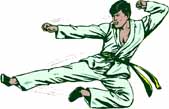|
KarateLearn about Karate – history, trainings, specifics and more…
Karate is a martial art which originated in Okinawa during the late 14th century through exposure to Chinese influences. At the time it was known as “Ti”. The start of empty hand combat techniques can be originated to the ‘ Policy of Banning Weapons’ in the early 17th century. As a young martial art it was very much influenced by the Chinese martial arts, specifically from Fujian province (this province is known for arts such as White Crane, Five Ancestors and more.) By the beginning of the 20th century, greater influences of Japanese martial arts can be found. It is mainly a striking martial art, but because of the Japanese influences some styles practice – grappling, locks, throws and restraints and submission holds. The first practitioners were farmers, which aside from using empty hand techniques also implemented farming tools as weapons. The fact that these farmers trained with their night robes, because they had to train at night for fear of prosecution, is the origin of the Gi. The name:The name means “empty hand” and as we saw in the Japanese martial arts, when adding “do” it means “the way”. So Karatedo works out to be “way of the empty hand”. However it was not always called Karate. It adapted its name only in the beginning of the 20th century during the rise of imperialism and militarism in Japan in order to be accepted by the Japanese budo organization. Up until then, no matter the style, the Chinese origin was apparnet in the name; such as “Tudi Sakukwa” – Sakukawa of China Hand. Evolution of karate and kumite or sparring
By the early 1930s’ the art was mainly trained through Kata/Form (A series of movements aimed to simulate fighting situations and improve the basic) training ( For more information about technical training…). Hironori Ohtsuka (Founder of Wado Ryu) one of Gichin Funakoshi (founder of Shotokan) students felt that the true spirit of karate can not be expressed or revealed through Kata training alone. In order for the style to be effective it had to experiment in real fighting and sparring or kumite. He blended techniques that he saw worked from other arts such as kendo, jujitsu, judo and more. Karate TrainingTraining in the art is recognized by two main characteristics one is mental and the other physical. Mental training – Karate-ka – karate trainees – are known for their aggressiveness in fighting and for their very high physical and mental endurance. From the very first lesson the student learns in a very disciplined atmosphere. Pain is considered to be a friend and fear the ultimate enemy, respect and honor are important virtues - these are parts of the samurai mentality which this art inherited. To learn more about Mental Training in a Martial Art Physical endurance – As part of its Fujian origin, physical endurance training is very much accepted in the vast majority of the schools. If it’s fist or fingers training, body endurance (parallel to Chinese iron shirt), leg endurance; or if it’s the muscles or bones. Practitioners are very “durable”, they break bricks, wood, stone or anything else imaginable, using their palm, fist, head, foot or any other body part. To learn more about Physical Training... RanksThe belt system or Dan system was introduced in the 1920s’ by Gichin Funakoshi to the system, it was adopted from Jigoro Kano the founder of judo. The student starts with a high Kyu (usually white belt) and works himself up to a lower kyu ,this is represented as a progression in belt color as he moves up the levels. After finishing the Kyu level the student reaches Dan level, first Dan or Shodan – usually signified with a black belt color. From then on the progression moves up the Dan grades. In most styles it is considered that only when reaching Shodan level will the student start to really learn the “real martial art”; the Kyu levels serve only as "preparing levels" for this stage. Advancing from one level to another is dependent on tests which examine physical, mental and technical attributes ( To see the Checklist).They can also examine knowledge in theory and system (To learn more about Martial Art Theory or Martial art Systems) However, in some cases, taking the test or passing it, depends on age, number of years at a rank and so on… These criteria’s vary from school to school and from style to style. Common Styles• Shotokan • Kenpo • Shito-Ryu • Wado Ryu • Goju-Ryu • Kyokushin (To learn about the founder) Common WeaponsThe ‘Policy of banning weapons’ made it impossible for the Okinawens to carry and train with normal weapons. Being farmers they used and trained with their every day farm tools. In time, though, more weapons were added into the system. However because of the origin - “Chinese hands” - empty hand combat was always emphasized. This phenomenon was even more highlighted as the art became a “do” system rather than a “jitso” one ( To learn more about Japanese Martial Arts): • Sai – Metal weapon like a fork used as a pair • Tonfa- A short stick made of wood with a handle, also used as a pair • Nunchaku – 2 wooden sticks joined by a cord or chain • Kama – Sickles used as pair • Bo – About 2 meters wooden staff • Shinai – Sword made of bamboo • Bokken – Wooden sword ConclusionsKarate is one of the most popular martial arts in the world today. It is trained as a sport, as a fighting art, or and as a way of life. It is very versatile and interesting, but like any martial art one must make sure he finds a school and teacher which are right for his needs.
To go back to Types of Martial Arts Learn about Kung-fu Return from Karate to Homepage |
